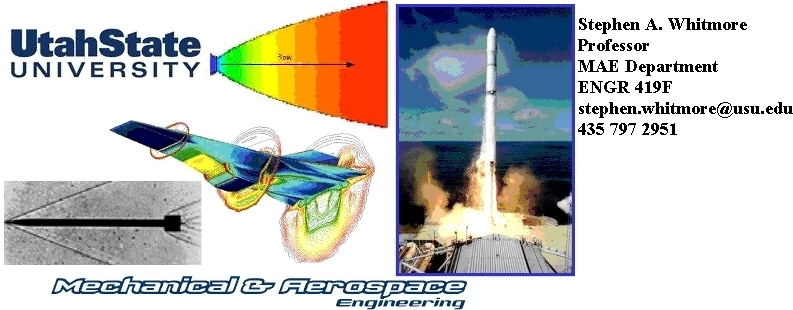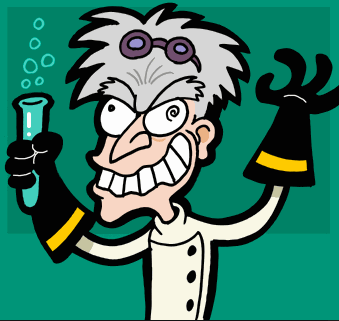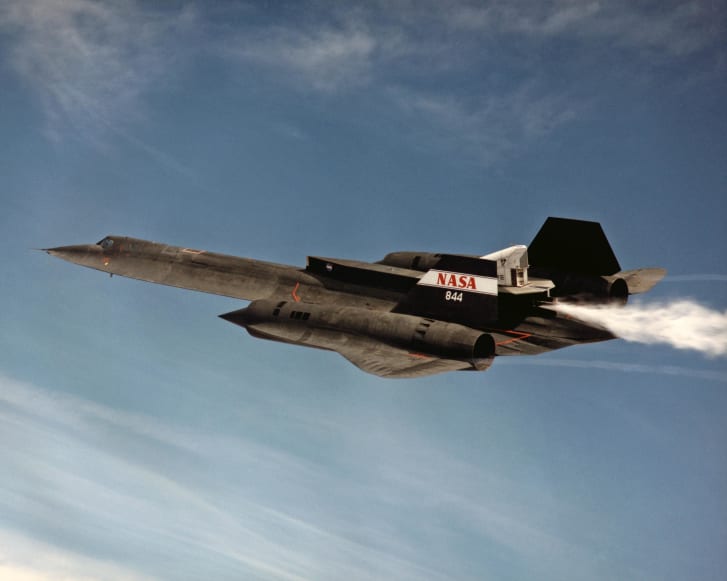

MAE 6530 - Propulsion Systems II
Fall 2021 General Course Information:
Administrivia
 Distance Learning and Lecture Archival
Distance Learning and Lecture Archival
Zoom Link for "Live" Virtual Lectures
- M,W from August 30 to December 8, 2021
-
Recorded and Archived Lectures
Homeworks
Contact
 Instructor Contact Information
Instructor Contact Information

Emails: class
Resources

- Utah NASA Space Grant Consortium, Student Career Webinar
- October 6, 2021,1:00-4:00 PM PDT
- Link
- Contact: Veronica Wilson, Western Regional Space Grant LiaisonVeronica.L.Wilson@nasa.gov
-
Caltech Space Challenge
- Titan Sample Return Mission
Downloadable Course Notes:
Each section listed below will span approximately 1 week
Posted notes are identical to notes presented in class
Section 1: Supersonic Characteristic Analysis Methods
- 1.1 Method of Characteristics Review
- Prandtl-Meyer Expansion Fan: Revisited
- Characteristic Lines
- Regions of Influence and Domains of Dependence
- "Method of Characteristics"
- Unit Process 1: Internal Flow Field
- Unit Process 2: Wall Point
- Unit Process 3: Shock Point
- Minimum Length Isentropic Nozzle Design
- Minimum Length Conical Nozzle: Construction Example
- Minimum Length Bell Nozzle: Construction Example
- NASA Glenn "Super-Sim" Method of Characteristics Code: https://www.grc.nasa.gov/www/k-12/airplane/supsim.html
- Method of Characteristics Nozzle Design Codes (LabVIEW 18):
- Summary of Calculation Solutions/Prscriptions for 2-D M.O.C.
- "Running Method" You Tube Link. https://www.youtube.com/watch?v=4fwiKjwDQMg
- Reference Publications
- 1.3 Conical Aerospike Nozzle
- Applying Method of Characteristics to Aerospike
- spike truncation
- Truncated Spike Comparison to Minimum Length Nozzle
- Aerospike Design Performance
- RS-27A AEROSPIKE Design profile
- RS-27A AEROSPIKE Over Expanded design performance
- RS-27A AEROSPIKE Under Expanded design performance
- Very High Expansion Ratio Spike Nozzles
2-D X-33 Aerospike on SR-71

-
1.4 Reference Materials
-
-
- 2019 Propulsion and Energy Conference
Section 2: Conical Flow Field Analysis
-- Anderson, Chapter 6 pp. 239-260, Chapter 10, pp. 363-375
Section 3: Hybrid Rocket Motors
- Introduction to Hybrid Rockets and Development of Hybrid Rocket Motor Model
- Advantages of Hybrid Rockets
- Typical Hybrid Propellants
- Model Modifications for Hybrid Rocket
- Propellant Burn Rate
- Enthalpy Balance Model
- Correlation of Heat Transfer to Skin Friction (Reynold's Analogy)
- Longitudinally Averaged Skin Friction
- Mixture Ratio as a function of Burn Rate
- Effect of Port Length on Mixture ratio
- Mass flow rates
- LOX/HTPB Hybrid example
- Introduction to Chemical Analysis with Applications (CEA) Code
- Exhaust gas properties as function of Mixture ratio
- Transient response
- Correlation of Burn rate to Oxidizer Mass Velocity
- Correction for Total Massflux
- Nitrous Oxide/HTPB Hybrid Student Project Introduction
- Hybrid Rocket Throttling
- Review of Liquid Bi-Priopellant Throttling
- Pressure Throttle
- Injector-feed Coupling in Pressure Throttled Rockets
- Effect of Pressure Ratio on Injector Feed Coupling Instability
- Injector Area Throttling
- Pintle Injector
- TRW Low Cost Pintle Engine
- Apollo Lunar Module Descent Engine
Applications of Deep Throttliong
- Hybrid Motor Throttling
- Effects of Radiation Heating
- Marxman Review
- Augmented Marxman Equation
- Radiation Coupling with Blowing Coefficient
- Comparisons to Experimental Results
- Reference Papers
- "Throttled Launch-Assist Hybrid Rocket Motor for a Towed Glider Air Launch Vehicle," AIAA-206-4658, 52nd AIAA/SAE/ASEE Joint Propulsion Conference Salt Lake City UT, 25-27 July 2016.
- "Closed-Loop Precision Throttling of a Hybrid Rocket Motor," J. Propulsion and Power, Vol. 30, No 2., March 2014, pp. 325-336.
- "Deep Throttle of a Nitrous Oxide and Hydroxyl-Terminated Poly- butadiene Hybrid Rocket Motor," J. Propulsion and Power, Vol. 30, No 1., January 2014, pp. 78-86
- "Thrust Modulation in a Nitrous-Oxide/Hydroxyl-Terminated Polybutadiene Hybrid Rocket Motor," AIAA 2006-4503, 42nd AIAA/ASME/SAE/ASEE Joint Propulsion Conference & Exhibit, 9-12 July 2006, Sacramento, California
- On the Flow of a Compressible Fluid through Orifices, Proceedings of the Institution of Mechanical Engineers, https://doi.org/10.1243/PIME_PROC_1955_169_077_02
Section 4: Introduction to Jet Propulsion and Airbreathing Cycles
- Introduction to Jet Propulsion Systems
- Operations Envelope for Various Flight Vehicles
- Airbreathing Propulsion Basics
- Brayton Cycle for Airbreathing Combustion
- Idealized Thermodynamic Model of Turbojet Engine
- Jet Engine Performance Parmeters
- Propulsive Efficiency
- Thermal Efficiency
- Total Efficiency
- Specific Thrust of Air Breathing Engine
- Air to Fuel Ratio Computations
- Equivalence Ratio versus Mixture Ratio
- Lean Burning: Why an Afterburner Works
- Thrust Specific Fuel Consumption
- Breguet Aircraft Range Equation
- Comparison to Rocket Equation
- Ideal Ramjet Cycle Analysis
- Control Volume for the Ramjet
- Ideal Ramjet Thermodynamic Cycle Analysis
- Cycle Efficiency of Ideal Ramjet
- Ideal Ramjet Example
- 1 vs. 2 stage Shockwave Compression Comparisons
- Supersonic Inet Examples
- "Starting" a Constant Area Ramjet
- Supersonic Combustion Ramjets (SCRAMjets) and Combined Cycle Engines
- Ideal Ramjet Cycle Analysis, revisited
- Thermodynamic Efficiency of Ideal Ramjet, revisited
- ScrRamjet Design Issues I, INLETS
- SCRAMJet Inlet Design
- Off Design Inlet Operation
- Inlet "Point Design"
- Comparison of X-43A Mach 7 and Mach 10 Inlets
- ScrRamjet Design Issues II, COMBUSTION
- 1-D Combustion Model review
- Rayleigh Eguations and the Second Law
- Differences between Subsonic and Subsnic Combustion
- Thermal Choking in Ramjet
- Thermal Choking in ScramJet
- Reaction Times in Supersonic Combustor
- Effect of Equivalence ratio on Combustion Stability
- ScrRamjet Design Issues III, Drag Losses and Vehicle Integration
- Comparison of Combustion Enthalpy and Incoming Air Enthalpy
- Comparison of Mach 20+ Integrated SCRAMjet Vehicle and Mach 7 Integrated SCRAMjet Vehicle
- Need for Combined Cycle SCRAM Vehicles
- Combined Cycle Mission Profiles
- ScrRamjet Design Issues IV, Heating
- Blunt Body Heating
- Sharp Leading Edge Heating
- Leading Edge Heating and Temperature Model
- Thermal Protection System Examples
- SCramjet Flight tests
- "Frontier Issues" in Hypersonic Flight Physics
Section 5: The Turbojet Propulsion Cycle
- Introduction to the TurboJet Propulsion Cycle
- Review, Thermal Efficiency of a Ramjet
- Ramjet Efficiency at Mach = 0
- Turbojet as an Alternativ Propulsion Cycle
- Turbojet Analysis Station Definitions
- Turbojet as an Idealized Brayton Cycle
- Thrust of an Idealized TurboJet
- Turbojet Cycle, Massflow Matching Requirements
- Overview of Component MatchingCriteria
- Turbine/Nozzle Flow Matching
- Freestream/Compressor Inlet Flow Matching
- Compressor/Turbine Flow Matching
- Collected Engine-Matching Conditions
- Effect of Afterburning
- Example Calculation
- TurboJet Compressor Design and Performance Features
- Review, Component Matching Conditions
- Gas Generator System Description
- Compressor Operating Line
- Corrected Massflow
- Corrected Engine RPM
- Compressor Performance Maps
- Compressor Stall/Surge Line
- Compressor Choking Line
- Compressor Surge Tutorial
- Two-Spool Compressor Design
- Effect of Compressor Operation on Engine Control
- Supersonic Inlet Flow
- Non-Ideal TurboJet Operation
- Review, Idealized Turbojet and the Brayton Cycle
- How is this Idealized Model Unrealistic?
- Combustor Losses and Inefficiencies
- Compressor and Turbine Losses and Inefficiencies
- Polytropic Expansion Coefficients
- Adjusted Brayton Cycle Plot for Non-Ideal TurboJet Operation
Section 6: The TurbofanPropulsion Cycle Analysis
- Ideal TurboFan Cycle Analysis
- Overview
- Review of Jet Engine Performance Efficiency
- Classification of Turbofan Engines
- Thrust of a TurboFan Engine
- The Ideal TurboFan Cycle
- Bypass Flow Analysis
- Core Flow Stream Analysis
- Turbine-Compressor-Fan Work Matching Conditions
- Air-to-Fuel Ratio
- Summary of Matching Equations
- Ideal TurboFan Cycle Analysis
- Optimal TurboFan Bypass ratio
- Review 1: Normalized Thrust and Isp
- Review 2: Fan/Core Sumary
- Review 3: Matching Conditions
- Example Turbofan Calculation
- Optimized TurboFan Performance
- Fan/Core Exit Velocity Differential Comparisons
- Bypass Ratio Criterion
- Discussion of Optimal TurboFan Performance
- Comparisons of Ideal and Non-Ideal TurboFan
Section 7: Launch Systems Design
- Rocket Science 101, Review of the 2-D Launch Vehicle Ballistic Equations of Motion
- Pegasus: Real World Launch Analysis Example
- Newtonian Dynamics
- Velocity Vector in Perifocal System
- Acceleration Vector in Perifocal System
- Forces Acting on Rocket
- Collected 2-D Ballistic State Equations
- Definition of Ballistic Coefficient
- Ballistic Coefficient Examples
- Ballistic versus Non-Ballistic Trajectories
- Numerical Integration of the 2-D Launch Equations
- Fixed Earth Approximation for Sounding Rocket Launch
- Ground Launch: Downrange Calculation
- Launch Rail Simulation
- Rail and Ballistic Simuation Flow Charts
- Rocket Science 102, Launch Energy Management
- Review of the Rocket Equation and Delta V Constraints
- Burnout and Apogee Altitudes for zero-Drag Conditions
- Energy Losses due to Drag
- How Drag Loss Effects Apogee Altitude
- Drag Coefficient Examples for Launch Vehicles
- Using Energy Managment to Target and Control Peak Altitude
- Total Mechancal Energy and the Concept of "Potential Altitude"
- Drag Dissipation and its Effects on Potential Altitude
- Energy Augmentation
- Effects of Horizontal Velocity on Energy State
- Energy Management with Error Envelope
- Example "Bang-Bang" Energy Management Control Logic
- Rocket Science 103, Estimating the Launch Vehicle Drag Coefficient
- Types of Aerodynamic Drag
- Skin Friction Drag
- Skin Friction Models
- 2-D Power Lay
- Basius for Bypass Transition
- 3-D Axisymmetric Karman Schoenherr
- Forebody Form (Pressure) Drag
- Drew and Jenn Correlation to Skin Friction
- Scale Factor Curve Fit
- Base Drag
- Hoerner Correlation to Skin Friction
- Effect of Boat Tailing on Base Drag
- Aerodynamic Fin Drag
- "Dither Drag" due to Vehicle Pitch/Yaw oscillations
- Leadind Edge Drag Corrections
- Total Drag Coefficient Model
- Compressibility Corrections
- Example Calculation
- Rocket Drag Profile Analysis Code, Based on Correlation Model (LabVIEW) (.zip)
- Rocket Drag Profile Analysis Code, w/Barrowman (Download and unzip above first)
- Missile Datcom, 1997 Edition (pre-ITAR Classification)
- Apogee Rockets AEROCFD (zip)
- RS103, Supplemental, Newtonian Flow Analysis
- Leading Edge Fin Drag from CpMax
- Tends to Overpredict L.E. Drag
- Refined Estimate Using Newtonian Model
- Original Newtonian Model from "Principia Mathematica"
- Impact pressure Based on Impact Pressure
- "Particle Counting" Method Valid only as Mach --> ∞"
- Modified Newtonian Flow
- Using CpMax to Estimate Impact Pressure
- Incidence Angle Methods
- "Tangent Wedge"
- "Tangent Cone"
- Detached Shock Wave Review
- Weak/Strong Solution Boundary
- Sonic Line
- Standoff Distance
- Calibrated Newtonian Flow Model
- Example Comparisons
- Homework 7.1 Blunt Leading Edge Drag Correction
- Longitudinal Vehicle (Pitch) Dynamics; Static, and Dynamic Stability (pdf)
- Formal Definition of Static, Dynamic Stability
- Center of Gravity vs Center of Pressure
- Weather Vane Analogy
- Static Margin and Picthing Moment
- Calculating the Static Margin
- Simplified Model of Pitch Axis Dynamics
- Collected Longitudinal Equations of Motion
- Decoupled Equations of Motion
- Example outer and inner-loop control strategies
- Recovery System Supplemental Lectures
- Parachute Systenms, Introduction and Overview
- Examples for Parachute Sizing and Pflanz Method for Load Prediction
- Reference Papers
- Drew and Jenn, "Pressure Drag Calculations on Axisymmetric Bodies of Arbitrary Moldline," AIAA 90-0280 .(pdf)
- Saltzman,
et. al, "FLIGHT-DETERMINED SUBSONIC LIFT AND DRAG CHARACTERISTICS OF
SEVEN LIFTING-BODY AND WING-BODY REENTRY VEHICLE CONFIGURATIONS WITH
TRUNCATED BASES," AIAA 1999-383. (pdf)
- Cronvich, "MIssile Aerodynamics," APL Tech. Digest, Vol. 4, No. 3, 1983.(pdf)
- Missile Aerodynamics for Ascent and Re-entry, NASA CR 2012-217475. (pdf)
- Cruz,
Juan R., "Parachutes for Planetary Entry Systems," Exploration Systems
Engineering Branch, NASA Langley Research Center, Hampton VA. (pdf)
- Parachute Recovery Systems Design Manual (Knacke) .. Amazon Link
Christmas Break Reading List!
1) This New Ocean
The Story of the First Space Age
By William E. Burrows
http://www.penguinrandomhouse.com/books/21787/this-new-ocean-by-william-e-burrows/9780375754852/
2) Dyna-Soar
The NASA Mission Reports
By: Robert Godwin
http://www.cgpublishing.com/Books/Dynasoar.html
3) A Brief History of Balls 8, the Famous B-52 that Served NASA for Almost 50 Years
http://www.stormclimb.com/2011/08/07/a-brief-history-of-balls-8-the-famous-b-52-that-served-nasa-for-almost-50-years/
4) Into the Black: The Extraordinary Untold Story of the First Flight of the Space Shuttle Rowland White
https://books.google.com/books?id=VP-qBAAAQBAJ&dq=into+the+black+first+flight+of+the+space+shuttle&hl=en&sa=X&ved=0ahUKEwiO3qTyqePQAhVHwWMKHXO3ApQQ6AEIIDAB
Books by Milt Thompson
5) Flying without wings: NASA lifting bodies and the birth of the space shuttle
https://books.google.com/books?id=HnRTAAAAMAAJ&source=gbs_book_similarbooks
6) At the Edge of Space: The X-15 Flight Program
https://books.google.com/books?id=I7PWAgAAQBAJ&source=gbs_similarbooks
7) On the frontier: flight research at Dryden, 1946-1981
Richard Hallion
https://books.google.com/books?id=XgP2SZ5-4mQC&q=history+of+nasa+dryden+flight+research+center&dq=history+of+nasa+dryden+flight+research+center&hl=en&sa=X&ved=0ahUKEwjJ8sb4qOPQAhUH4GMKHbFgCBcQ6AEIJDAC
Return to Lecture Notes Web Page
 Distance Learning and Lecture Archival
Distance Learning and Lecture Archival
Distance Learning and Lecture Archival
Instructor Contact Information
